Comparing Synthetic Watercolour Brushes – Part 4

Comparing Synthetic Watercolour Brushes – Part 4 is the fourth of my blogs and linked films, questing for a synthetic watercolour brush to replace the sable ones made by Winsor & Newton. My Winsor & Newton series 7 number 1 size is my go-to brush, and has been for years.
Today I’m reviewing Bille Showell’s fine liner, ProArte Masterstroke Series 60 Round, Rosemary & Company Designer Red Dot, and the Winsor & Newton Cotman 111 round
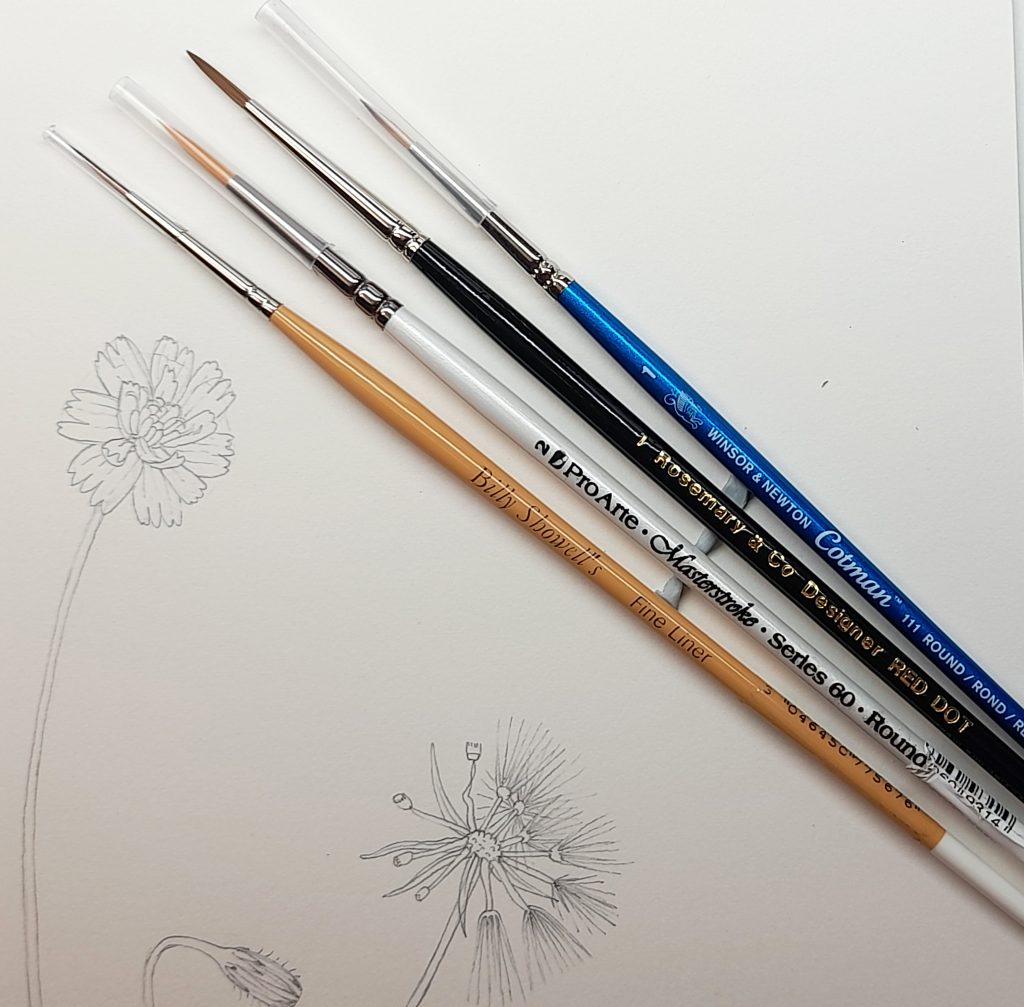
Four brushes to be tested today
I’m testing the brushes on a botanical illustration of a Lesser Hawkbit, being completed for Braunton Burrows and FSC Publications, so it’s vital I don’t ruin the illustration as I test these four contenders! The linked Youtube film is here.
Synthetic Brushes Tested so far…
I’ve worked my way through about 15 synthetic brushes, without stumbling on the Holy Grail of replacements. Of the ones I’ve tried (see below), my favourites to date are the Princeton Neptune round (a synthetic squirrel) and Rosemary & Company Red Dot Spotter, a synthetic sable.
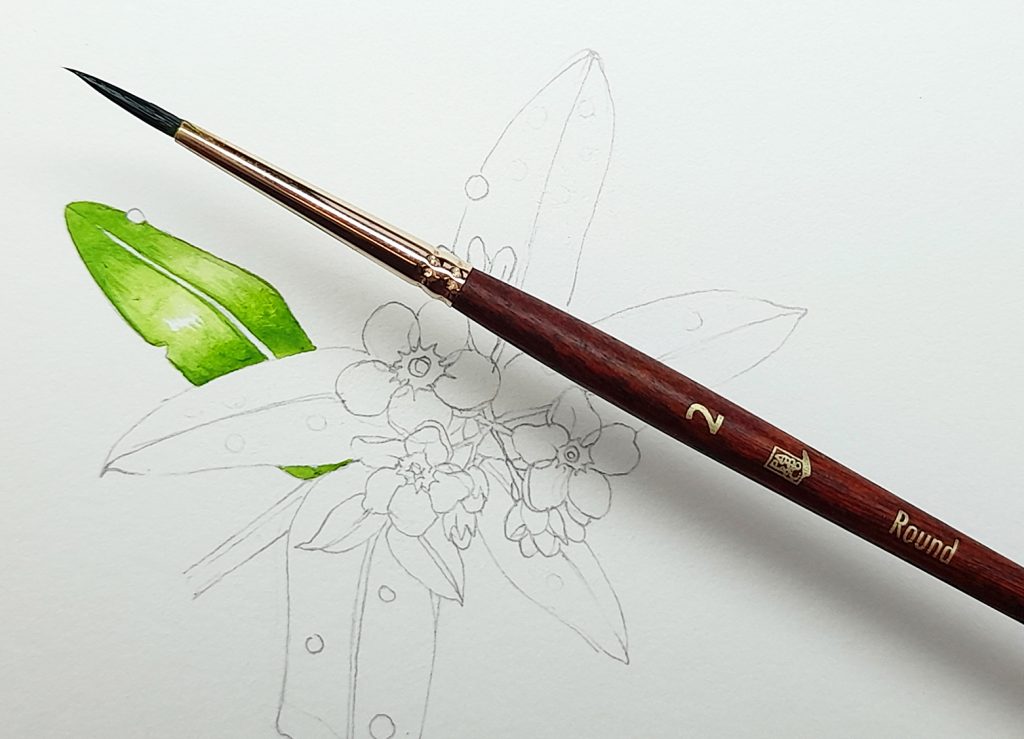
Princeton Neptune Round
Film 1 (and blog) shows me trying out Winsor & Newton synthetic sable, Rosemary and Co. Spotter Red Dot, Princeton Aqua elite, and my one freebie – the ZenART fineline minature paintbrushes
In film and blog 2, Princeton Neptune script. Kite S561 by Jackson’s, Rosemary and Company Pointed Red Dot, Da Vinci Casaneo 5598 Round are under the spotlight.
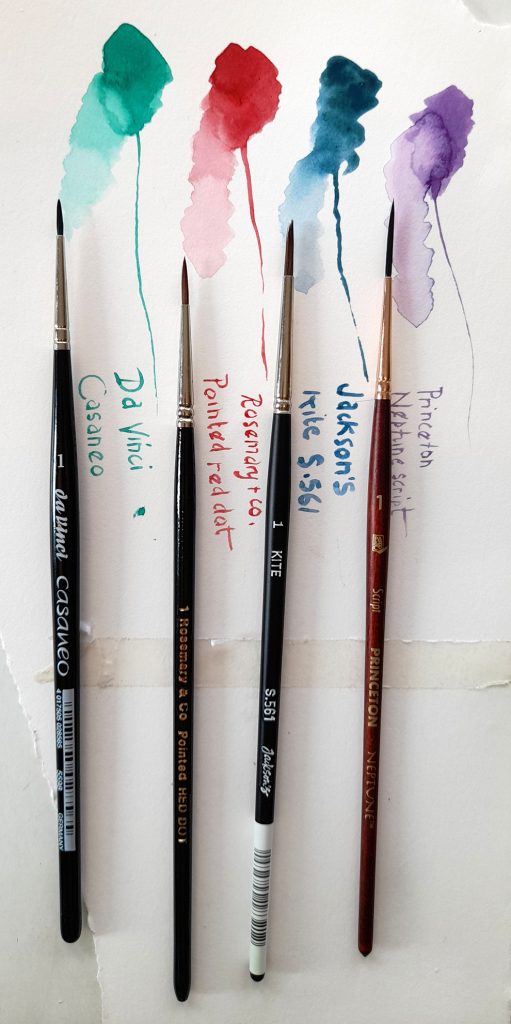
Brushes tested in the second blog and film
Blog and film 3 saw me review Princeton Neptune round, Jackson’s Icon synthetic Quill S777 10/0, Escoda Versatil round, and Da Vinci Colineo.

Brushes tested in the third blog and film
Synthetic Brush reviews: Unsponsored and honest
I’ve paid for and sourced all my brushes myself (bar one – ZenART fineline minature paintbrushes). I buy most from Jackson’s because they carry a wide range (again, there’s no paid promotion here). They also seem to make a point of packing their supplies in a sensible, minimal way, in entirely recyclable packaging. Other art suppliers here in the UK are also good; Cass Art, Cowling and Wilcox, Ken Bromley, and London Graphic Centre spring to mind.
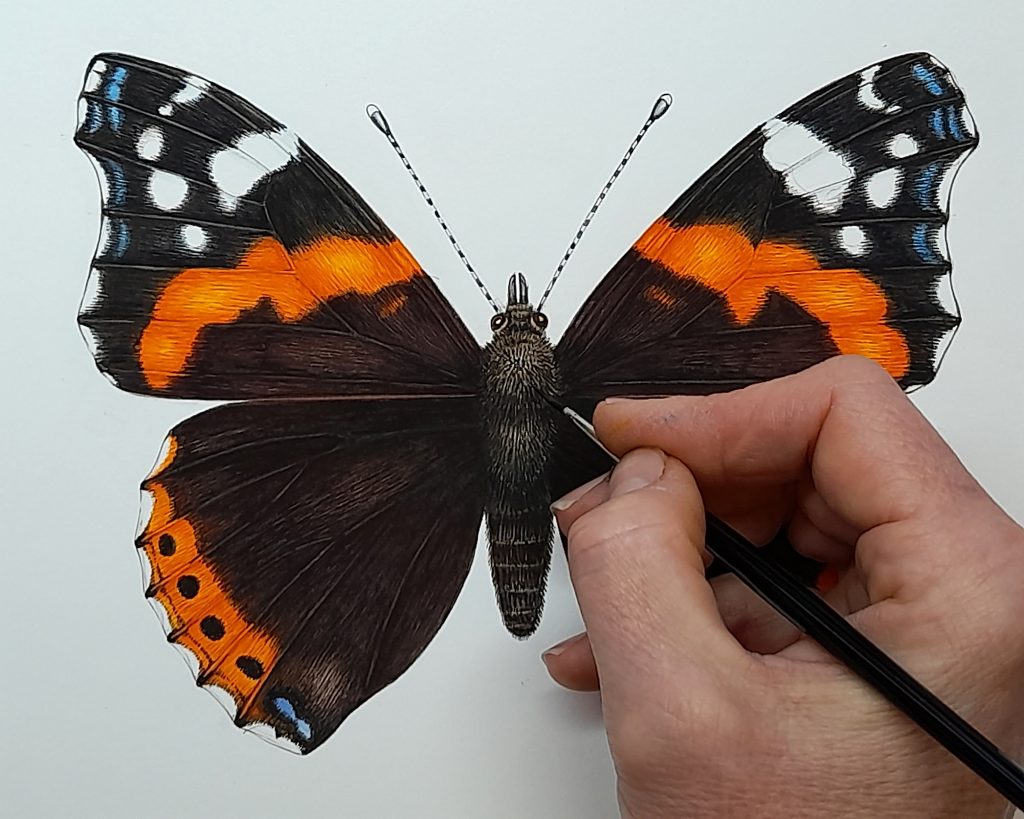
Working on a Red Admiral Buterfly with my Series 7 sable brush
Of the brushes tested, only the Rosemary & Co range need to be purchased direct from their website, either online or by phone.
Not being sponsored or given materials to try has made this a rather expensive quest, but has guaranteed that my opinions are objective.
Any replacement is not only going to have to perform as consistently well as my Series 7, but also needs to overcome my inevitable familiarity and affection for a tool which works so well for me.
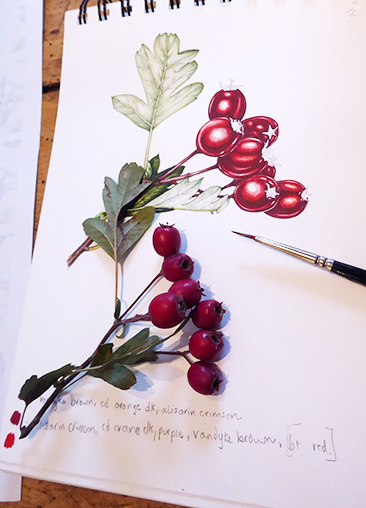
Hawthorn berries with Series 7 brush
Please do remember that all of these opinions are mine, and brush choice can be intensely personal. Just because I love or loathe a brush is no guarantee that you’ll feel the same. I wouldn’t want to end up preaching or changing the way people feel about brands they love, but just hope some of my research may help others on a similar quest.
Why look for a synthetic waterolour brush?
The main reason for my quest is ethical. I’m into nature and am a committed vegetarian. Sable and squirrel brushes are made from bristles of the squirrel and the sable, a weasel-like animal. I don’t like to be a part of this trade. Price is also relevant, a new Series 7 brush in my favourite number 1 size can cost more than £25. Most of the synthetics I’m trialling cost under £10.
Bille Showell’s fine liner: The new brush
On first sight this is an elegant brush, very slim handle and a tasty looking tip. The point is long and thin, and free from stray hairs or a hooked tip.
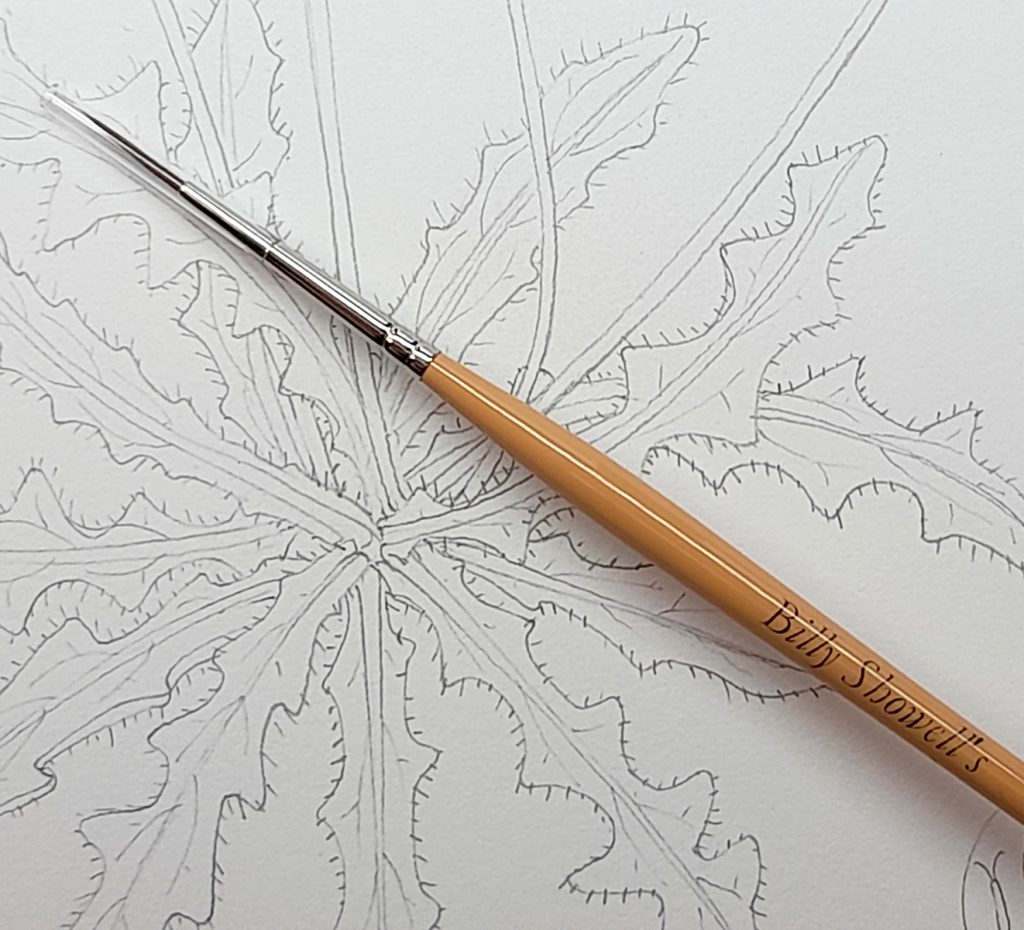
Billie Showell’s Fine liner: Mixing paint
The problem with this brush is that it is so fine that it’s unable to hold much paint. So when I do my mixing, it takes ages to get enough of a colour to mix up a decent batch of paint. There’s an obvious solution to this, of course. Use a different brush for mixing than the one you use for painting. But I’m a lazy sort of illustrator, and decided a while ago that I didn’t have time to be switching between mixing and painting brushes all the time.
Mixing with it, once I had enough paint on the palette, worked out fine. The longer nib made mixing swift. And it did not shed hairs or alter shape as a result of the mixing process.
I’m not used to working with long nibbed brushes and riggers though, and that made it hard for me to warm to the brush. The fault is mine, and not down to a problem with the fineliner.
Billie Showell’s Fine liner: How sharp is that point?
The point is simply perfect. It is extremely fine, and utterly reliable. I had no concerns at all about the width of the line varying without me wanting it to, and felt very safe using it. I kept thinking how perfect it would be for incredibly thin individual lines, things like insect hairs or mammal whiskers.

Every now and then, though, when one thin line crossed over another, the brush would catch and blob a bit. This was pronounced as I tried to paint the delicate pappas of the Hawkbit seedhead.
Despite using it for quite some time, the point did not alter or deteriorate. It’d be perfect for painting in hairs on the stem of a plant. Anything requiring more of a bulk of colour? It would do the trick, but would take an age to get enough pigment onto the page.
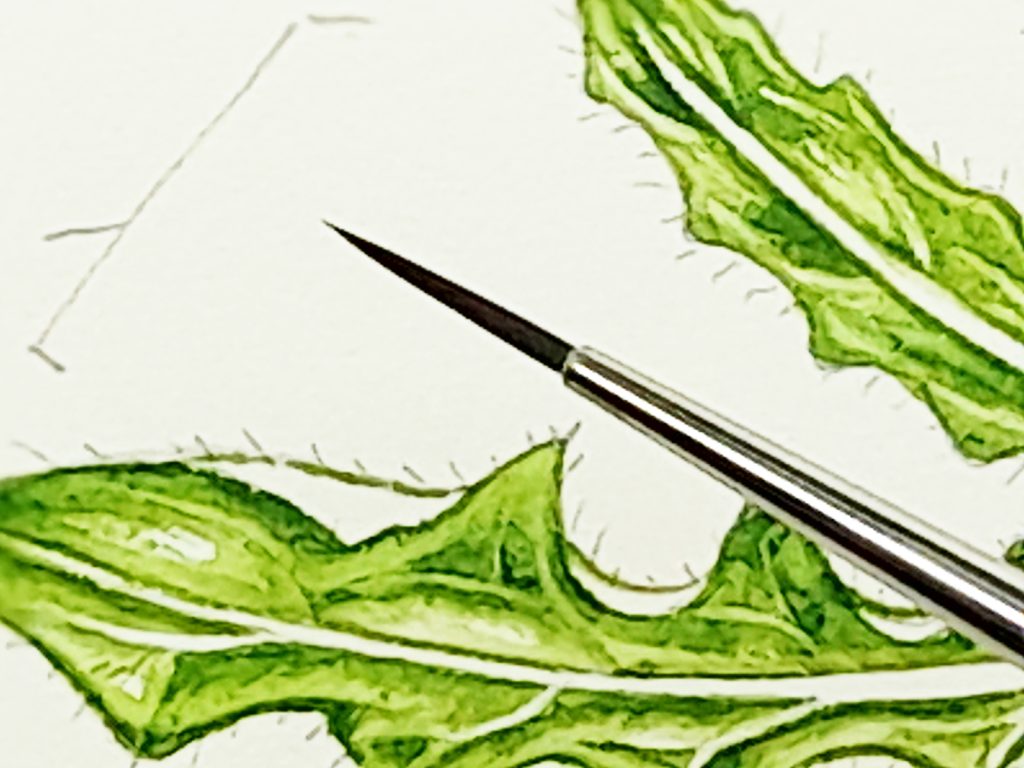
Billie Showell’s Fine liner: The Blob Test
In the blob test, this brush did brilliantly. One confident thin or thicker line? It passed with flying colours. Writing the name of the brush with the brush? Easy peasy.
However, when it came to making a tint of the colour, this brush simply didn’t have enough bulk. It couldn’t carry enough water to add to the paint, and the blob started to dry out before I could dilute it properly.
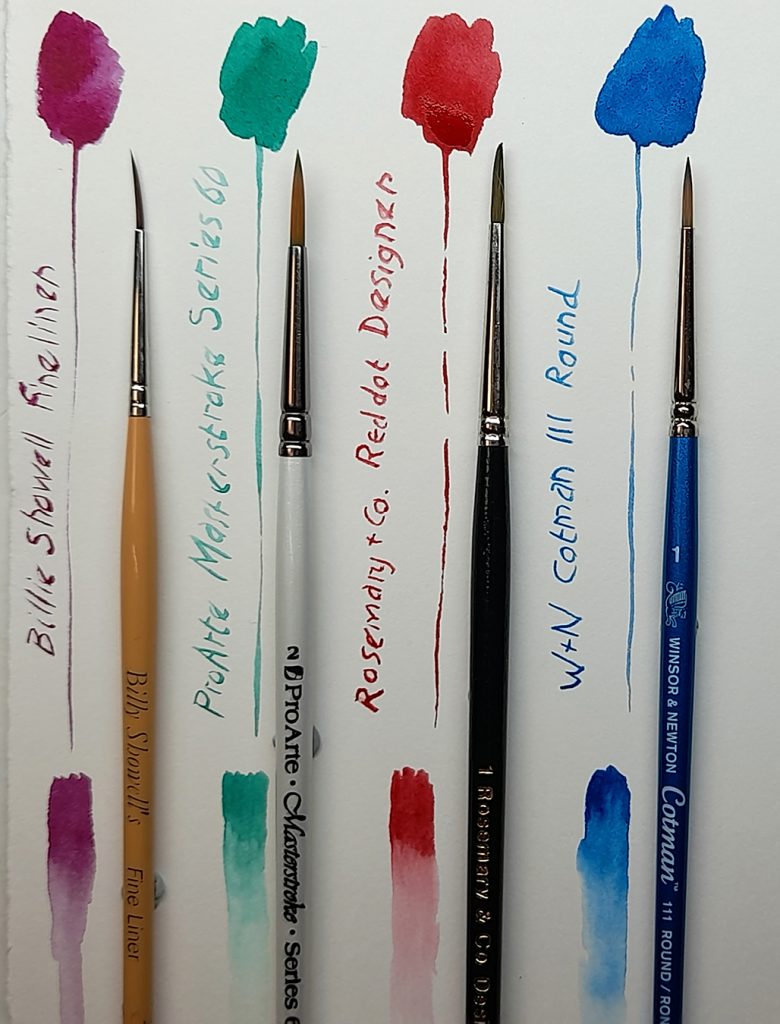
Blob Test: Billie Showell fineliner on the left
Billie Showell’s Fine liner: Conclusion
This is an excellent brush when it comes to providing super-elegant thin lines. The brush held its’ shape and was easy to use, and gave reliable performance. The drawback is that because of the thinness of the nib, it’s time consuming and hard to get much colour onto the page. This would preclude it from being useful as an all-around brush. It can do the detail, but not the body colour. A caveat here, this is almost exactly what it says in its write-up on Jackson’s website. According to the blurb it is, “excellent for fine and precise details and for producing long, thin and accurate lines”. Which, if nothing else, proves that the reviews on websites are sometimes totally honest!
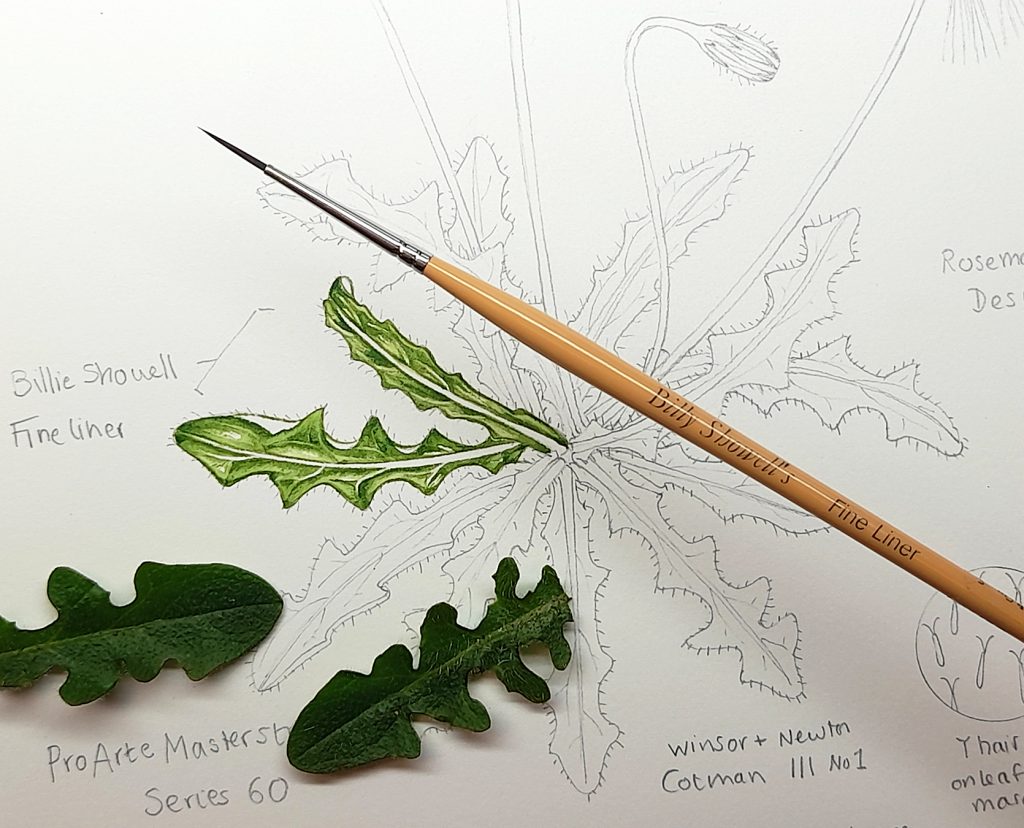
This brush currently retails from Jackson’s UK for £4.60
ProArte Masterstroke Series 60 Round size 2: The new brush
This brush is a number 2 size as there were no number 1 size in stock. As well as being called Masterstroke Series 60 round, it also seems to call itself “Craft & Decorative 50609314”
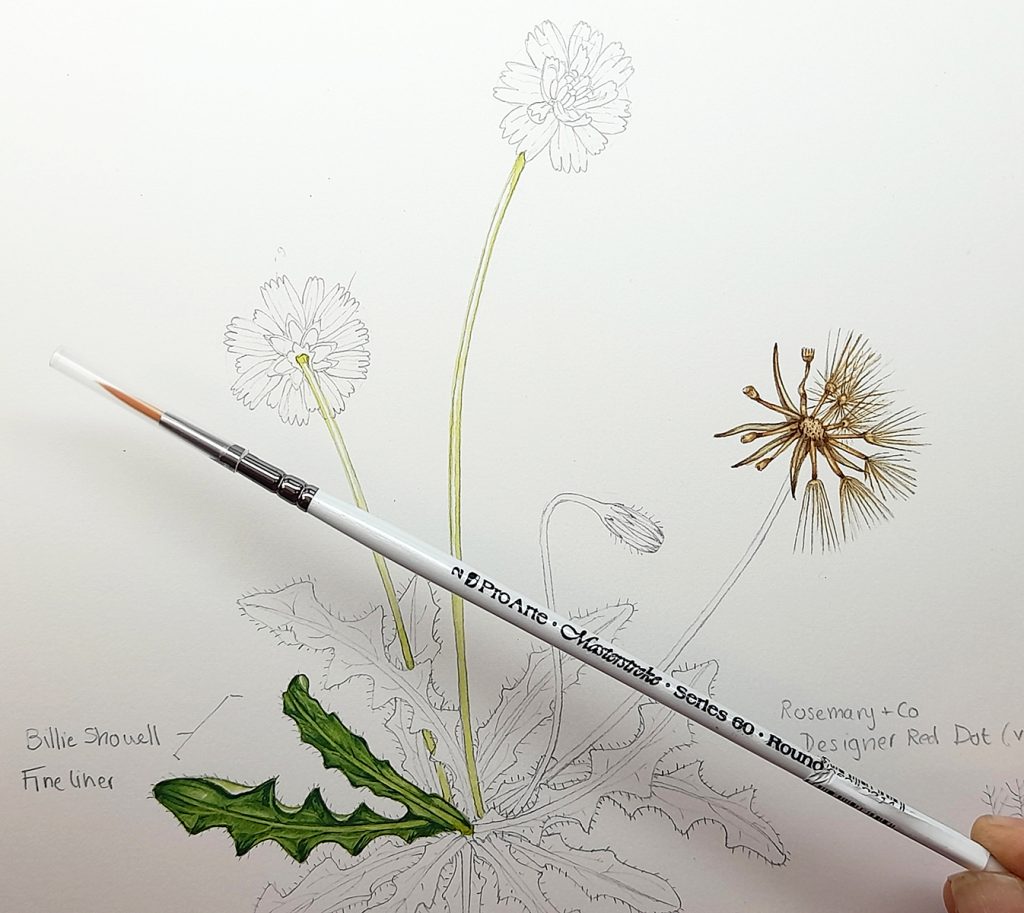
On removing the plastic cover, it shows a broad well which should hold plenty of paint, and a sharp point.
ProArte Masterstroke Series 60 Round: Mixing paint
Mixing is good and easy. The brush carries plenty of colour to the palette, and doesn’t lose its’ fine point after mixing colours together. Often you can predict a brush’s behaviour by what the nib looks like when you’re mixing up, and in this case things auger well.
ProArte Masterstroke Series 60 Round: How sharp is that point?
The point IS sharp. However, there’s too much in terms of bristles and paint going on behind the sharp tip. Even when concentrating really hard, splurges of paint would fall from higher up the brush and distort the line the fine nib was drawing. I really struggled to keep my lines fine and accurate, and felt very worried that at any moment a big blob of paint would fall onto my illustration. This was especially true after each visit to re-charge the brush from the palette.
When it came to wet top washes, I didn’t feel certain that I could stay within the lines. Again, it’s that lack of predictability.

Later on, I also noticed that the bristles were really stiff and I could actually hear them scratching on the page as I painted.
It’s not an appalling brush by any means, it just hasn’t got the tip reliability I’m looking for.
ProArte Masterstroke Series 60 Round: The Blob Test
Getting the paint onto the page, and making the initial blob was easy. Using the very tip of the brush, with no directional change, gave a good fine line. However, I didn’t feel able to rely on it remaining a consistent thin line.
Whilst making a tint of the main paint I noticed the scratchiness of the bristles again.
I was able to write the brush name alright, but it wasn’t comfortable.
ProArte Masterstroke Series 60 Round: Conclusion
Despite the competitive price and good point on this brush, the heavy well resting right behind the tip made it feel a bit scary, as if it could drop a big blob of paint at any time. The tip held, neither hooking nor splaying, which is a definite plus. But I can’t pretend to have enjoyed painting with it.
If I were working a little larger, with a lightly less intense need for detail, this brush might be a good choice. The nib point certainly impressed. The insecure feeling it gave me did not.
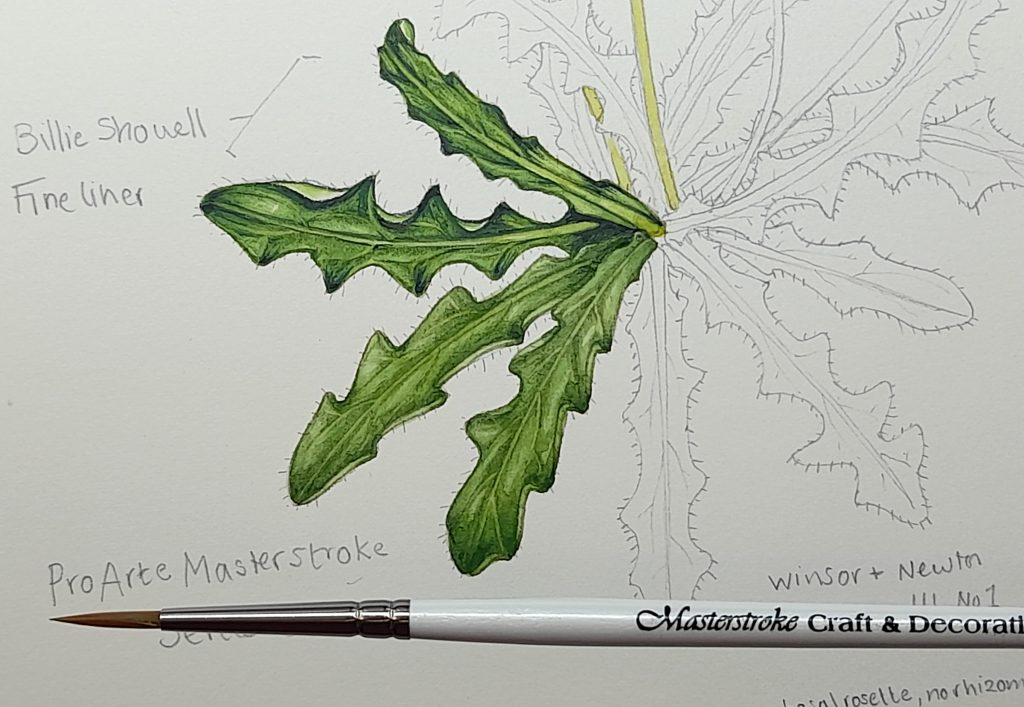
At Jackson’s, this brush currently sells for £2.10
Rosemary & Company Designer Red Dot no 1: The new brush
I was really excited about this brush. Having got on so well with the Red Dot Spotters (although less well with the Red Dot Pointed) by Rosemary and Co, I expected great things. I really did think that this could be THE ONE.
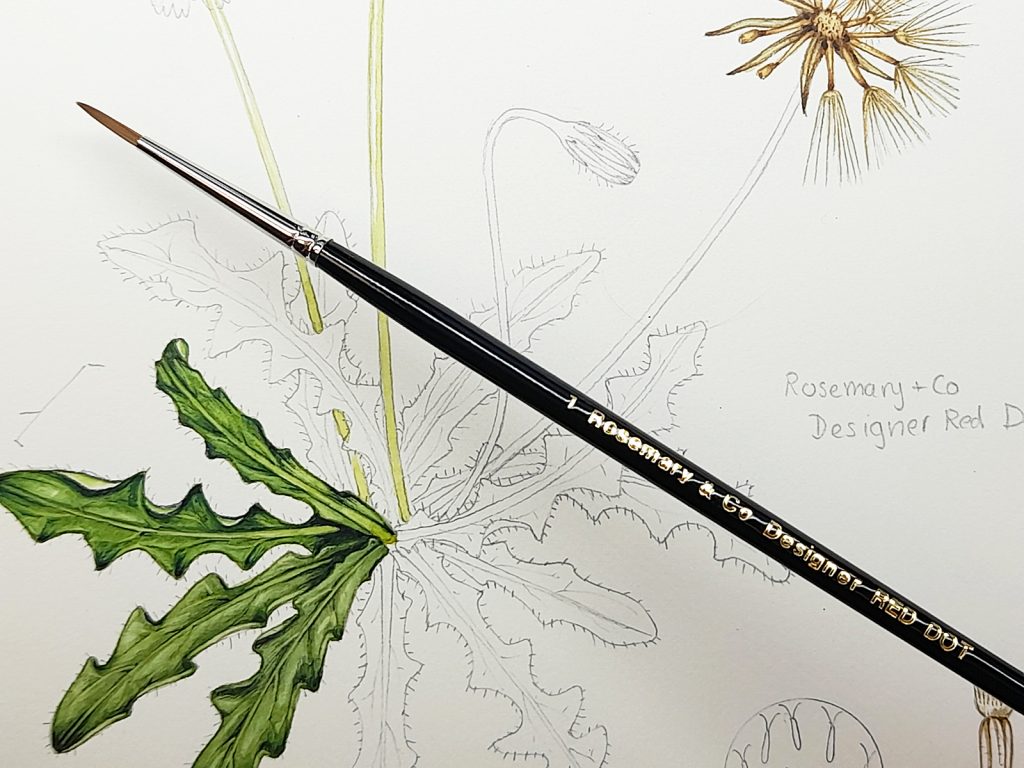
Taking it out of its’ packaging, the nib looked sharp enough. The brush has the look and feel of my Series 7, which already works in its’ favour.
Rosemary & Company Designer Red dot: Mixing paint
When I use the brush to mix paint, it collects plenty of pigment from the pans and has a good enough well to carry plenty of paint. However, looking at the brush as I finish mixing it already seems to have blunted, and the tip looks a little bent.
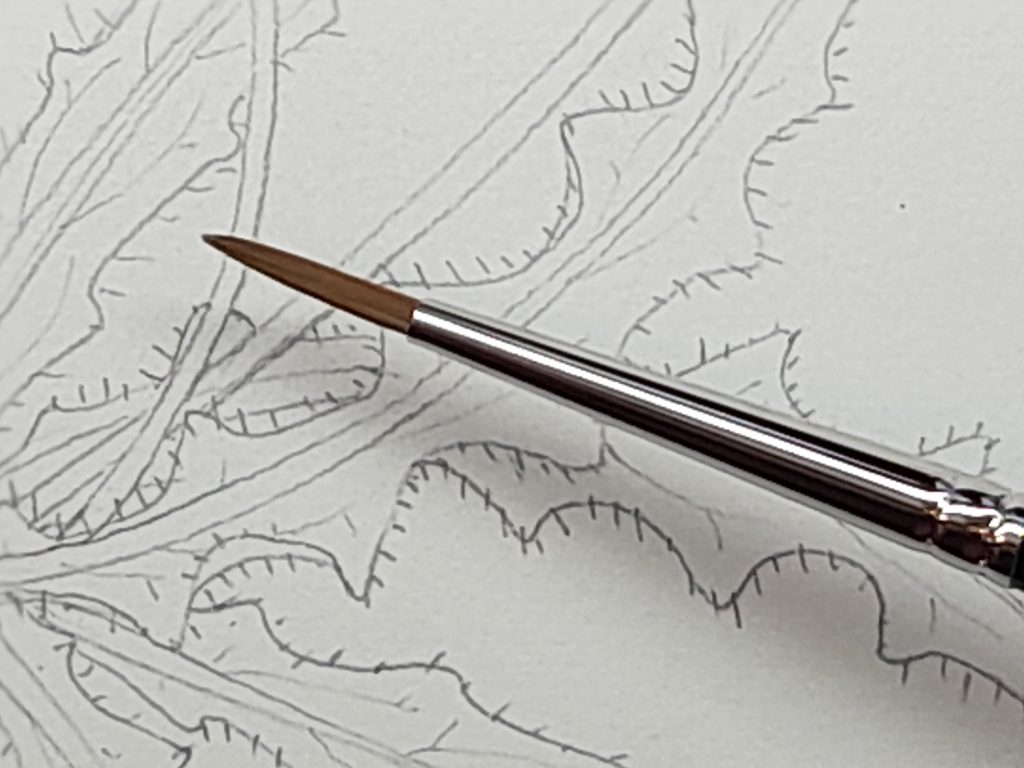
Rosemary & Company Designer Red dot: How sharp is that point?
Despite my misgivings, initially the brush does ok. It creates fine lines, reliably. Not brilliant, but workable. It doesn’t feel like it’s about to leave blobs or to let me down. In that way, it’s a safe brush.
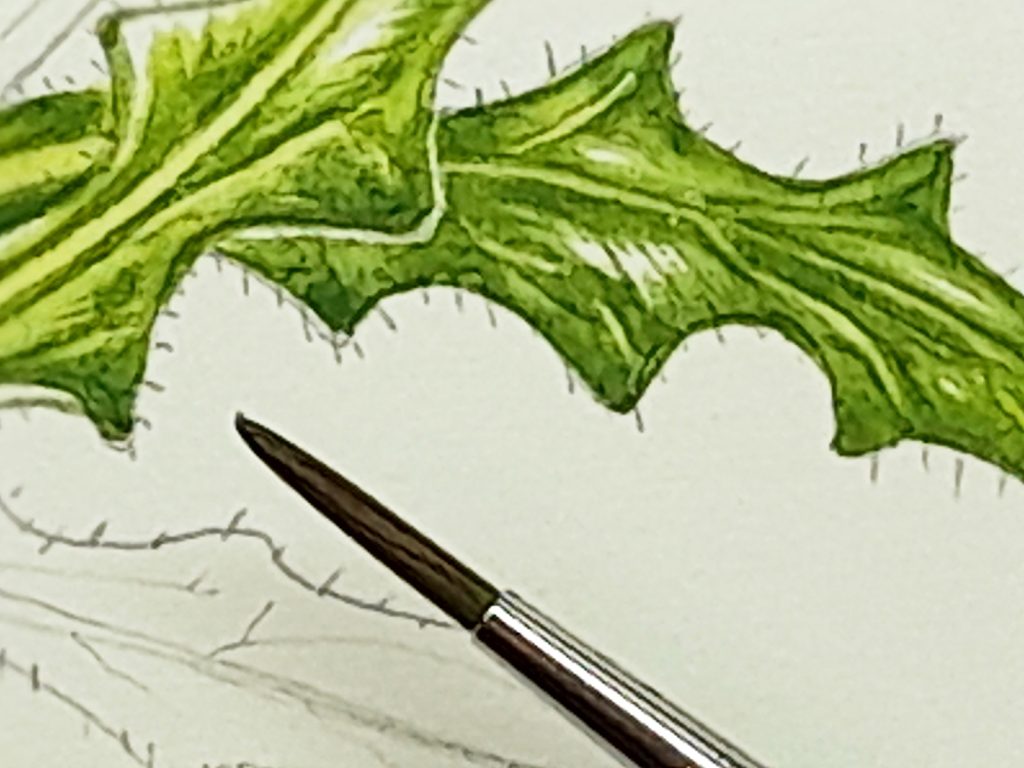
But within 5 minutes, the shape of the brush has changed. It’s become flattened, almost compressed. This means the tip is wide and flat, and you end up having to paint on a “corner” of the nib to get a clean thin line. It continues to degrade and becomes hooked in the short time spent trialling it on film.
This is not only disappointing, but also confusing. Many extremely good botanical illustrators, far better then me, adore these brushes and swear by them. Maybe it’s because I mix and paint with the same brush? Maybe I’ve just landed some dud brushes?
Rosemary & Company Designer Red dot: The Blob Test
Delivery of a nice big blob of colour was fine, as was mixing tints of the colour by diluting it with water. But when it came to trying to produce a reliable thin line? Or the result when I tried writing with it? The hooked tip made this impossible. The line was too thick, and broken. The nib was blunted, scratchy, hooked, and simply couldn’t deliver.
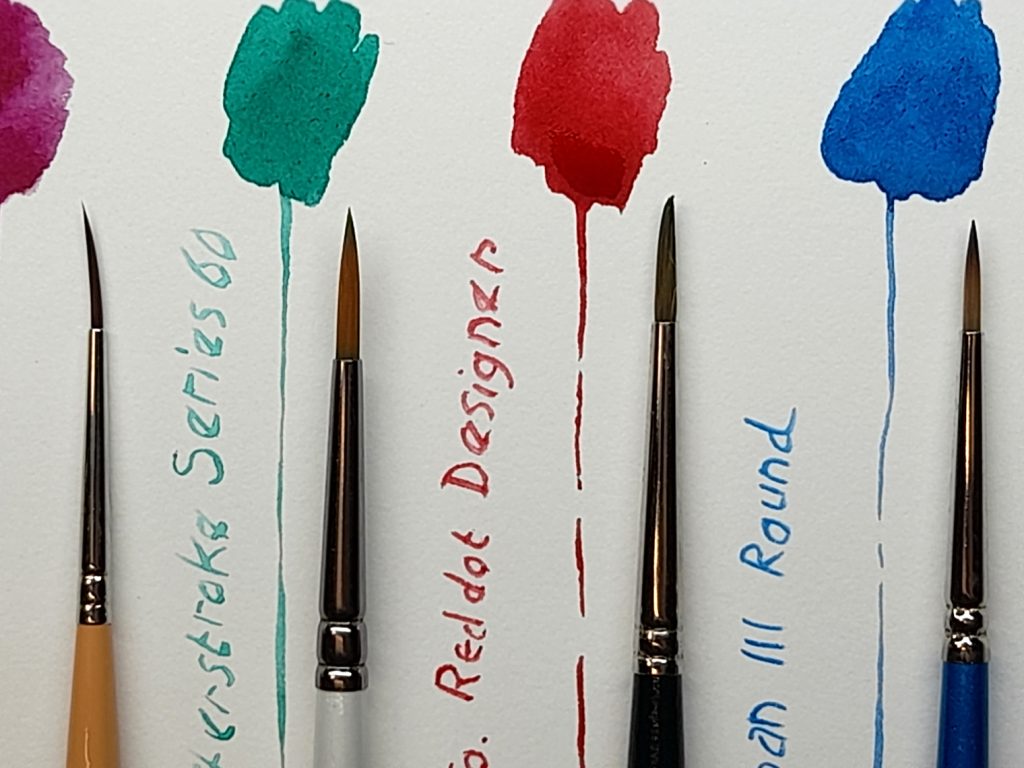
Rosemary & Company Designer Red dot: Conclusion
By the end of the test, I found myself saying, “I feel like I’m painting with a brick” which explains why this brush ended up being my least favourite of this batch.
The tip flattened, then hooked and deteriorated really fast. The brush carried plenty of paint, has a decent sized well, and didn’t blob. But that tip ruined it for me, I’m afraid.
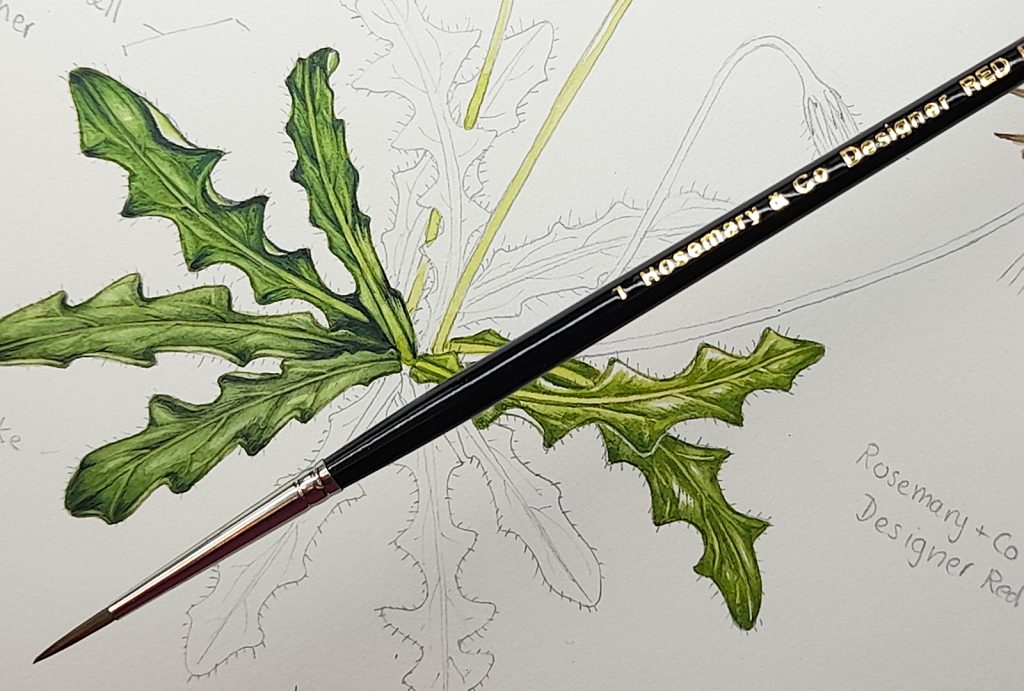
Currently, this brush sells for £3.35 direct from Rosemary & Co.
Winsor & Newton Cotman 111 round size 1: The new brush
The new brush looks very tempting. The shiny blue handle appeals to someone like me (really into sparkly things) and the nib looks sharp and unhooked.
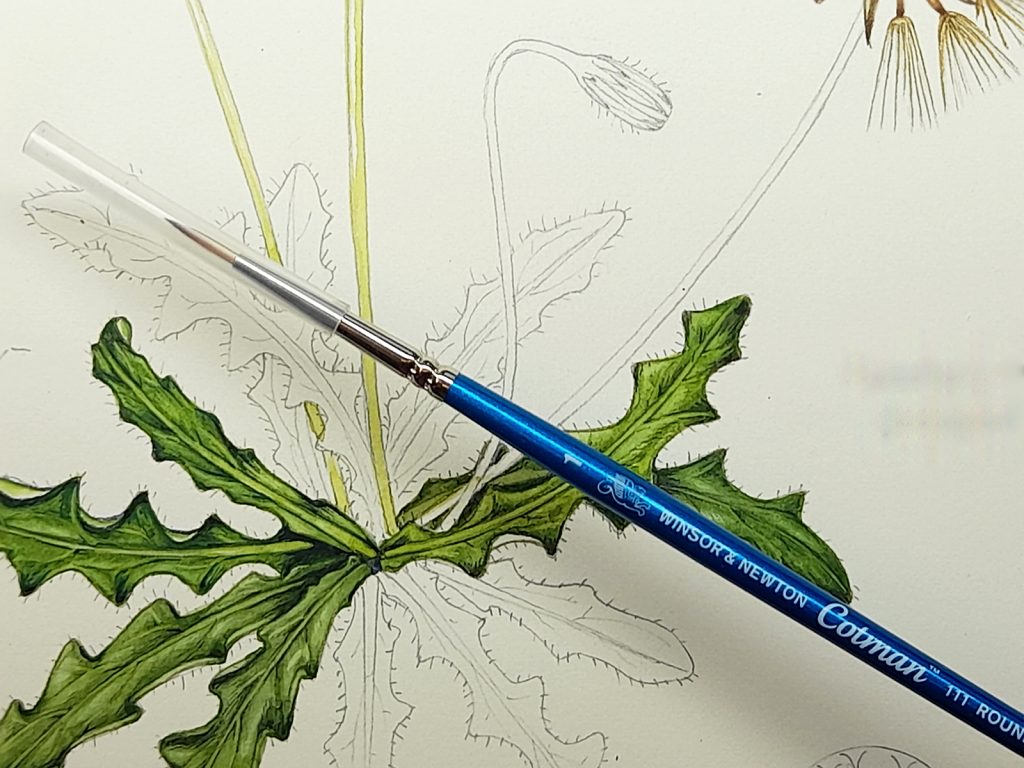
Winsor & Newton Cotman 111 round: Mixing paint
Mixing goes well. There’s enough of a well to take plenty of colour from the palette. No bristles are shed as I mix, and the nib doesn’t deteriorate too much. By the time the mix is complete, it does look a little blunter, though.
Winsor & Newton Cotman 111 round: How sharp is that point?
The Cotman seems to hold its’ point relatively well. It certainly doesn’t deteriorate as fast as the Red Dot designer or the ProArte Masterstroke S60.
However, the brush as a whole feels a bit floppy. It’s as if the bristles can’t stand up to any pressure, bending and flattening with the slightest touch. This is the first brush I’ve tested that has this flaw. Some others had bristles which were too stiff, these aren’t stiff enough. I’m beginning to feel like Goldilocks!
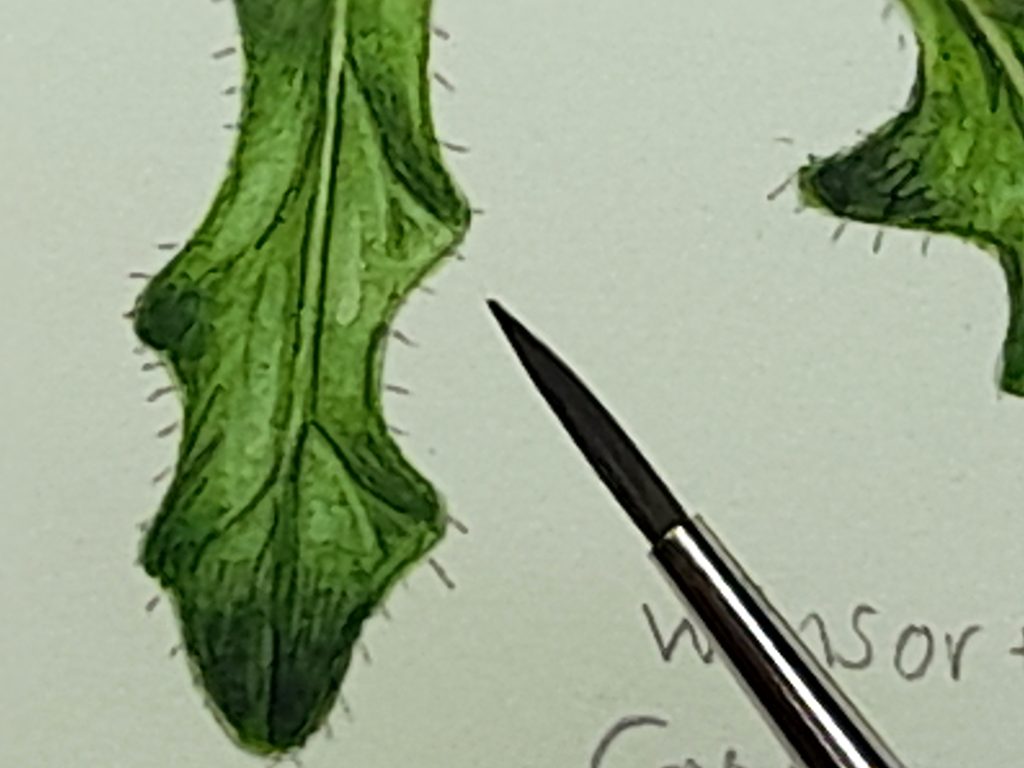
This softness meant it was harder to control the paint, and use the tip. Unexpected flexibility led to unreliability.
Winsor & Newton Cotman 111 round: The Blob Test
The blob test showed the flaws as well as strengths of the brush. It gave a nice blob of colour, but the tiny hook that had developed on the tip meant the thin line was not as reliable as I’d hoped. And the soft bristles made it hard to judge how much water to add to mix up a decent tint of the colour. Writing with it was ok, although the soft bending made forming the letters a touch challenging.
Winsor & Newton Cotman 111 round: Conclusion
This brush did a great job of holding its’ tip to start with, and after use had only developed a small hook. It’s a pretty brush, and I really would have liked it to work out. But a combination of a slight bluntness from that hooked tip, coupled with the strangely soft and pliant bristles made it uncomfortable to work with.
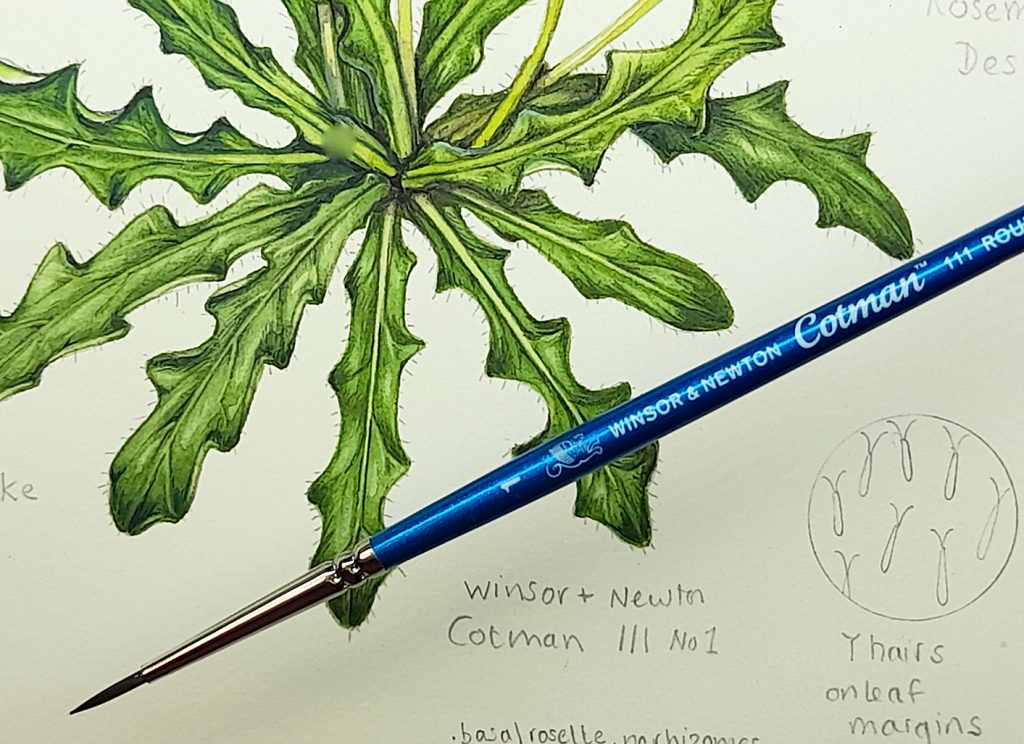
Yes, it was my second favourite in this batch. But no, I won’t be buying another one or using it again.
This brush is currently selling at £4.40 from Jackson’s.
Synthetic brushes: A hint to help fix hooked tips
Curved or hooked tips is a recurrent problem with most synthetic brushes, but may not mean the end of your paintbrush. This tip came in from Rebecca, who left this suggestion in the comments section of my Synthetics 2 blog. (It tallies with advice on hooked tips from the Rosemary & Co website). Many thanks for sharing it with us. “Hooks that develop on synthetic bristles can often be remedied by dipping the bristles about half way into a cup of water taken off the boil. Take care not to get the ferrule or upper bristles wet with water this hot or it may affect the glue. The timing varies from 10-30 seconds based on the brand and size. Gently reshape the tip on your thumbnail after heating. While I don’t expect that is an annoyance one would want to deal with during a long painting session, it will at least restore the brush to a usable condition for lighter tasks.”
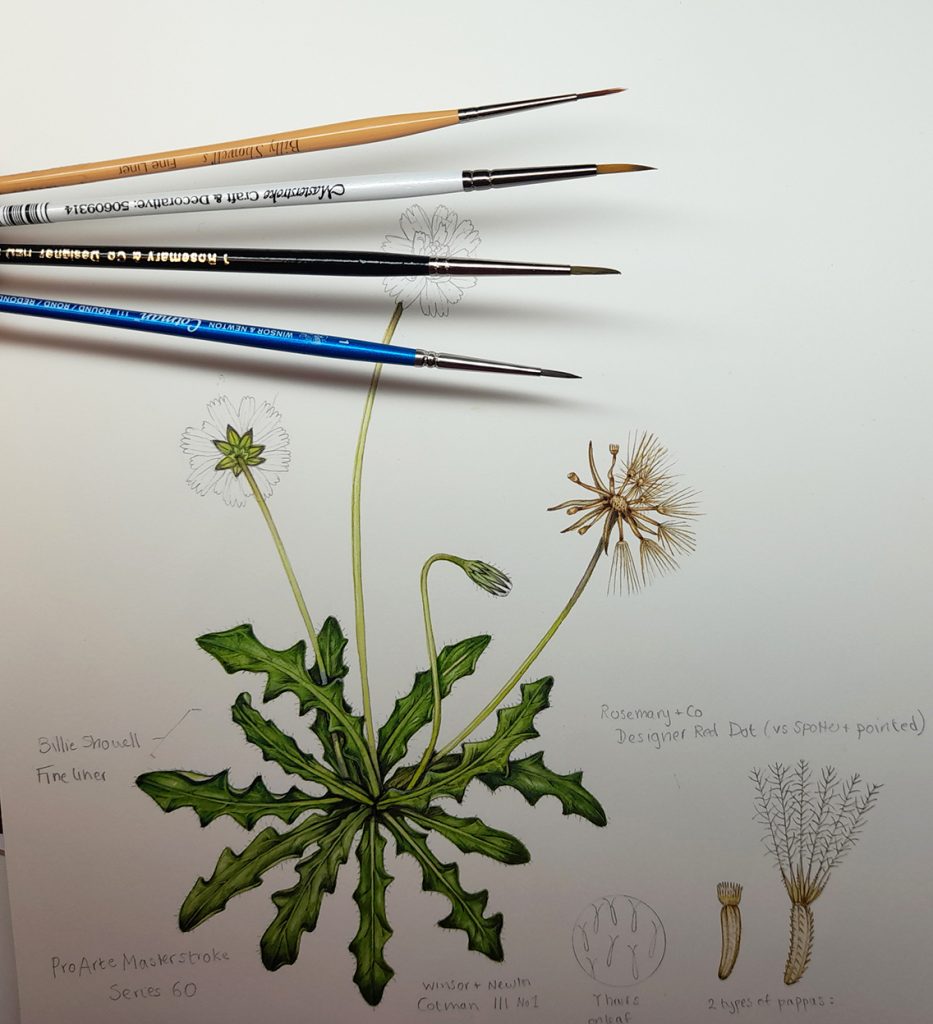
All four brushes – even at this distance you can see the hook on the Rosemary & Co Designer
Conclusion
So four brushes were tested. The Billie Showell was too long in the nib and couldn’t carry much paint. But gave a fabulous thin line. The ProArte Masterstroke S60 felt blobby and unreliable (although it held its’ tip well). The Red dot Spotter was a dud, and left me bitterly disappointed as its nib deteriorated into an un-useable state in under 10 minutes of use. The Cotman held a point wonderfully to being with, but felt floppy. For me, only the Billie Showell is worth using again. I’ll turn to it when I need to do very fine thin lines. But even this one isn’t going to be a replacement for my normal Series 7. The quest continues.
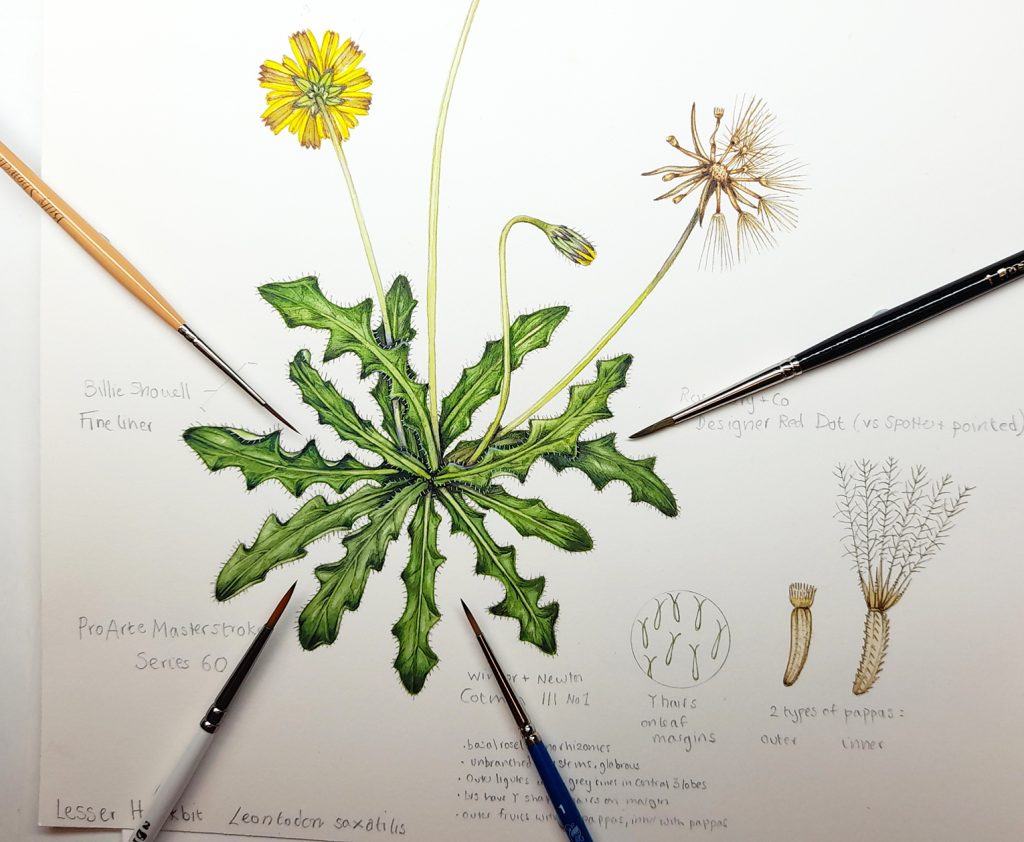
All four brushes next to the leaves they have illustrated
I’ve decided to do one more set of tests, then give up (or at least stick to the one or two brushes that just might be good enough to rival my sable brushes). So the last four brushes are ordered, and as I’m a hopeful creature, I’m keeping everything crossed that next time, next time will see me stumbling across the Holy Grail.
In the meantime, thanks so much for sticking with me on my seemingly endless quest, and see below for a !!Youtube film!! of this comparison.
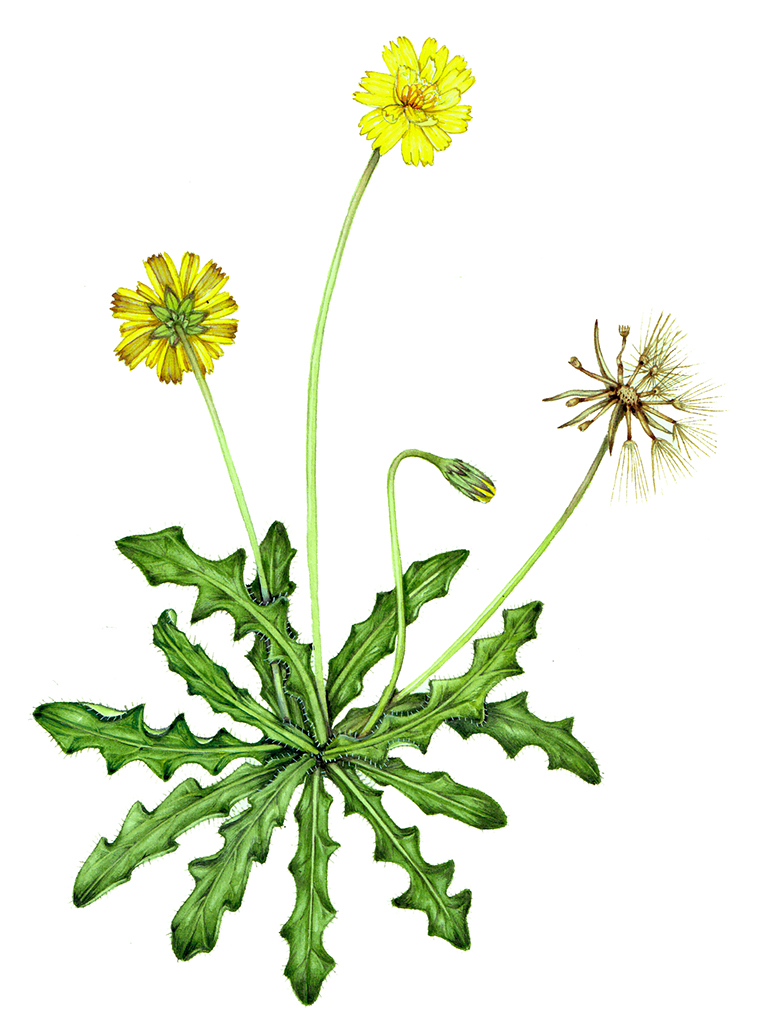
Completed Lesser Hawkbit Leontodon saxatilis.

